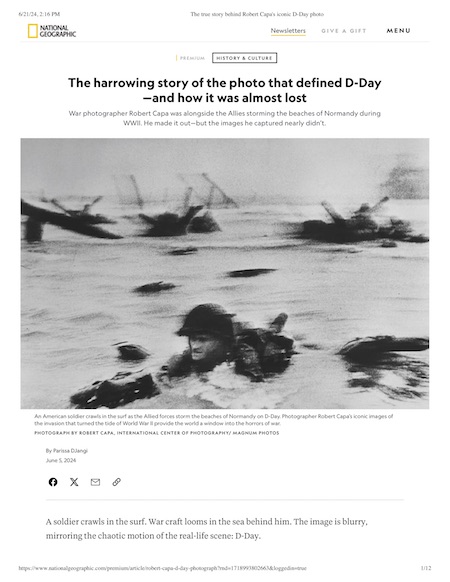 Ten Years On
Ten Years On
Hard to believe that ten years have passed since the Capa D-Day project premiered here at this blog. I truly had no idea what I was getting myself into.
That debut took place on the 70th anniversary of the invasion. Perhaps needless to say, at the time the Capa D-Day myth held sway as a dependable subsection of the D-Day story. Firmly entrenched in the histories of photography and photojournalism, it had succeeded in infiltrating military history while making cameo appearances in the autobiographies of such Hollywood figures as Ingrid Bergman and Sam Fuller. A myriad variants had appeared not just in printed sources and films and videos but online. Without question, it had gone viral; arguably, it had achieved the status of a meme.
With (to my present knowledge) only one deeply obscure exception, the legend of Capa’s hours on Omaha Beach and supposedly ruined negatives had gone unchallenged since the photographer seeded it in the summer of 1944. By dint of sheer repetition, and its folkloric appeal, it had implanted itself in the imaginations of countless people around the world, including professionals in several fields. Contradicting any part of it qualified as a fool’s errand; dismantling it in its entirety would surely prove a hopeless task.
Nonetheless, we have persevered — through the 75th anniversary of that momentous event, and now past the 80th. With the results of the 80th anniversary coverage now in, fair to ask how we’ve done in our deconstruction of the story. (The first part of this survey appears below. Click here for part 2.)
•
The (Revised) Story So Far
To start with, an overview: Commemorative coverage of the 80th anniversary of D-Day and related events proved sparse by comparison with what appeared on both its 70th and 75th predecessors. Predictable on several counts. First, after a big blowout like the 75th anniversary of just about anything the next five-year marker usually experiences a fall-off in interest and attention.
Second, demographic attrition of the generations that experienced World War II directly or indirectly — through older family and friends — results in an inexorably shrinking population of individuals who hold that conflict in “living memory.” As it recedes from personal consciousness, it becomes increasingly remote, merging into an impressionistic mid-20th-century montage. I would expect that distanciation to continue and even increase between now and the centennial celebration in 2044.
Consequently, this occasion evoked far fewer usages of Capa’s Omaha Beach images, and fewer versions of the Capa chapter of the larger D-Day saga. Indeed, some attention even turned to other photographers and cinematographers who made notable documentation of the Normandy landings — though not, alas, to U.S. Signal Corps photographer Herman V. Wall, who deserves a chapter to himself.
•
 In that context, how did our project fare? To initiate the assessment I plugged the keywords “Robert Capa D-Day 2024” into two search engines, Google and DuckDuckGo. In both cases this brings up, as top results, links to recent/current stories that refer to our research. Adding my last name to the keywords — “Robert Capa D-Day Coleman 2024” — mixes into the top results an assortment of posts here at the blog, articles on the subject I’ve published elsewhere online, and earlier articles by others addressing our investigation.
In that context, how did our project fare? To initiate the assessment I plugged the keywords “Robert Capa D-Day 2024” into two search engines, Google and DuckDuckGo. In both cases this brings up, as top results, links to recent/current stories that refer to our research. Adding my last name to the keywords — “Robert Capa D-Day Coleman 2024” — mixes into the top results an assortment of posts here at the blog, articles on the subject I’ve published elsewhere online, and earlier articles by others addressing our investigation.
This reflects the algorithmic effect of search-engine procedures. Ten years’ worth of traffic to our project at my blog, and to chunks I’ve published elsewhere online based on our research, plus links to these materials from other blog posts and websites, have steadily raised our investigation in the rankings of Google and other search engines. As a result, awareness of our deconstruction of the myth has become close to unavoidable, even for the most casual surfer with only passing interest in this subject. Given the way that search-engine algorithms work, this focus of attention on our investigation will necessarily increase over time. That’s one unexpected benefit of three factors of our project: the initial decision to “journal” it by blogging a running account of our inquiry, its extent, and its longevity.
 Certainly a web version of
Certainly a web version of
It does take time. And effort. But it’s worth it. As the I Ching advises, “Perseverance furthers.” We can say with confidence that, as of now, anyone doing even cursory research on Capa’s D-Day photos will at least come across reference to our project. And anyone pushing further by seeking additional information will find direct links to the project itself. That in itself bodes well.
The Envelopes, Please
Coordinated with the 80th anniversary of D-Day, two prominent U.S. publications ran feature stories responding to our research. The first, Smithsonian Magazine, published “These Astounding Relics From the Omaha Beach Battle Tell The Story of D-Day 80 Years Later” by Frank A. Blazich Jr., on May 21, 2024 at its blog (but not in its print edition). Blazich is a curator of Military History at the National Museum of American History, a division of the Smithsonian Institution in Washington, DC. The illustrations for the article, including several of Capa’s Omaha Beach images, all come from the museum’s collection. Blazich’s account includes this passage:
 … Farther down Omaha Beach at Sector Easy Red, photographer Robert Capa arrived at the shore around 8:15 a.m. with the command group of Company E, 16th Infantry Regiment, 1st Infantry Division.
… Farther down Omaha Beach at Sector Easy Red, photographer Robert Capa arrived at the shore around 8:15 a.m. with the command group of Company E, 16th Infantry Regiment, 1st Infantry Division.
As part of the 13th wave of the landings, he spent 30 minutes on the beach capturing images of the invasion before returning to the attack transport vessel USS Samuel Chase.
On June 19, five of Capa’s images graced the pages of Life magazine, bringing the invasion home to Americans. …
Capa’s landing time, the wave and cohort with which he arrived, and the duration of his stay on Easy Red as given in this article all come directly from Charles Herrick’s analyses as published here at this blog.
Mercifully, Blazich skips any recounting of the myth, simply treating our revision as verifiably factual. Unfortunately, he introduces a small but significant error into the above narrative: While the LIFE issue featuring Capa’s D-Day images bears the dateline June 19, it hit the newsstands on June 12. And those Capa images distributed through the press pool got into print even before that. So Americans, and others around the world, got to see some of Capa’s D-Day reportage a week or more before June 19th — in some cases, just a few days after the landing.
Robert Capa, D-Day, front page, Ashtabula Star-Beacon, June 9, 1944
•
Ahead of its appearance at the Smithsonian website, this article got published at several different sites:
- “A jacket, a coin, a letter: Relics of Omaha Beach tell the D-Day story,” by Frank A. Blazich Jr., Smithsonian Institution, at the website The Conversation (self-described as “Academic rigor, journalistic flair”), on May 10, 2024.
- Under the same title — a variant of the original article’s subtitle — at the website Military.com, on May 13, 2024.
- Again under the same title at the website Military Times on May 16, 2024.
Yet, simultaneously, just a few mouseclicks away in cyberspace, the Smithsonian’s National Museum of American History peddles the myth uncritically. Witness, at its website, the unsigned caption “‘D-Day,’ by Robert Capa,” featuring Capa’s first Omaha Beach exposure and a quick rehash of the fable:
… Dodging bullets and hiding behind pieces of steel, Capa photographed for hours in waist-deep water with several Contax cameras. His hands trembled, and he ruined many rolls of film as he tried to change film amid the dead and wounded of the battle. Capa did make his way to the shore, but soon after found himself jumping aboard a barge to rest and dry off, not realizing the boat was returning to its main ship. Capa didn’t get back to shore again until the fighting had ended.
Capa’s D-Day [sic] was sent directly to the offices of LIFE in London for processing. Hurrying to develop the rolls, a technician turned up the heat in the dryers, ruining many of the 72 images taken. Only 11 survived.
So either the museum’s left hand doesn’t know what its right hand is doing, or the institution has demonstrated its negative capability. Or — and I admit this is a stretch — it operates under what we might call a “Schrödinger’s Capa” condition of uncertainty.
•
(As long as I’m listing specialized military-history sites that have taken recent notice of our project, let me add War History Network, which published “6 June 1944: D-Day Through Two Different Lenses” by Scott Lyons on February 24, 2024. In this piece Lyons compares and contrasts U.S. Coast Guard photographer Robert F. Sargent’s iconic image known as “Into the Jaws of Death” with Capa’s D-Day reportage. His commentary on Capa’s work draws heavily on our project, leaning particularly on the research of Charles Herrick.)
•
The second prominent U.S. publication to make reference to our project, National Geographic, offered “The Harrowing Story of the Photo that Defined D-Day – and How it was Almost Lost,” by Parissa DJangi, on June 5, 2024. This appears at the NatGeo website only, not in the magazine’s print edition. Unfortunately, it’s behind a paywall there. Apparently it also got distributed via email blast to subscribers to NatGeo “newsletters.”
 No great loss, because basically it merely rehashes the myth, with a brief mention of our research. With that said, it’s the only 80th-anniversary story that mentions the name of any member of the research team and includes an active link to any of our material. To wit:
No great loss, because basically it merely rehashes the myth, with a brief mention of our research. With that said, it’s the only 80th-anniversary story that mentions the name of any member of the research team and includes an active link to any of our material. To wit:
… Capa wrote that he had snapped 106 photographs on multiple film rolls, which he sent to Life magazine’s London office. But in the rush to print the photographs, so the story goes, nearly all of Capa’s negatives were accidentally destroyed in the darkroom when a drying cabinet overheated.
Yet some have cast doubt on this story and parts of Capa’s D-Day account. Photography critic A. D. Coleman later interrogated Capa’s claims, concluding that he may have been on the beach only long enough to take a handful of pictures. The darkroom disaster, he argued, never happened.
Whatever actually occurred, the result was the same: Only 11 negatives survived, as Life picture editor John Morris would later clarify.
Helpfully, this passage even includes a link to my 2019 Exposure article sketching our findings up to that point. So, if only for those reasons, it’s relevant here.
Unfortunately, this rehash includes some tellingly false details. The water on Easy Red at the moment Capa disembarked was visibly ankle-deep, not waist-deep. None of the pictures show corpses, much less any “piled up around [Capa].” “The Face in the Surf” is neither Huston Riley nor Edward Regan, as we’ve proven. And there were never 11 negatives made on Omaha Beach — only ten. That’s a lot of easily avoidable error to pack into such a short piece.

Parissa DJangi, National Geographic, Capa D-Day story, 6-5-24, screenshot
•
Assuming that this was not generated by AI, this is typical of what you can expect to get when you assign a generalist “cultural journalist” to any serious topic: parroting of the received ideas, plus hackneyed bothsiderism.
(Note: While I can’t provide a working link to the article as published at the NatGeo site, this article got republished in full under the headline “The true story behind Robert Capa’s iconic D-Day photo” on June 6 at the website JNews. Possibly it appears there without permission from either NatGeo or DJangi, as it’s credited to “admin.” From what I can gather, JNews is blogware created by WordPress for the express purpose of content aggregation — which, bluntly put, involves scraping content published elsewhere online and repurposing it as your own ostensible product. The appearance of this in the top search results demonstrates the effectiveness of such unauthorized appropriation in attracting eyeballs.)
Credit Where It’s Due
Of course we welcome the above validations of our investigation by Smithsonian Magazine and National Geographic. Yet it remains a peculiar fact, for which I have no explanation, that the most substantial engagement with our project by any prominent U.S. publication came five years ago, in the form of a feature article (with accompanying slideshow) published on the 75th anniversary of D-Day at the website of the American Association of Retired Persons (AARP). See “The Story Behind D-Day’s Iconic Images,” by Michael Hedges, datelined June 5, 2019. Here’s an excerpt:
It’s a great yarn that Capa and Morris retold all their lives — Morris died in 2017 — and that countless others repeated. But this year the photography website PetaPixel published a detailed examination of Capa’s activities that day that could change the narrative.
The piece, written by A. D. Coleman, concludes that Capa got to a relatively less dangerous section of the beach than he claimed and stayed about 15 minutes — probably taking only the 11 surviving images — before returning to a landing craft headed back to the invasion fleet. Capa had admitted to a panic attack, but another motive, according to published accounts, was the need to make a tight deadline so his photos could reach the U.S. in time for Life’s next issue.
And the tragic lab accident? The PetaPixel piece quotes experts saying it couldn’t have happened the way it was described.
 I wrote about this unexpected and fortuitous attention to our project at the time. Hedges serves as an Executive Editor at AARP, involved with its print and digital publications. He brings to it an impressive background. From his LinkedIn profile:
I wrote about this unexpected and fortuitous attention to our project at the time. Hedges serves as an Executive Editor at AARP, involved with its print and digital publications. He brings to it an impressive background. From his LinkedIn profile:
Curious as to how this assignment came about, I emailed Hedges to inquire. He told me that Michael Wichita, AARP’s Director of Photography, had brought our project to his attention.
As I noted when that article first came out,
AARP is one of the biggest organizations in the country, in terms of membership. Its main publication, AARP The Magazine, gets huge distribution (38.3 million), and I assume its website reaches many members, plus others. Though not a long article, this piece by Hedges does direct readers to the full text of my lecture at PetaPixel. And it does basically accept without reservation our research.
That article remains the most supportive acknowledgment of our research in any large-circulation U.S.-based publication. Not surprisingly, it shows up today highly ranked in search-engine results. Consequently, it has almost certainly driven heavy traffic not just to that PetaPixel article of mine but to our research here. …
(Part 1 I 2)
•
(For an index of links to all posts in this series, click here.)
•
This post supported in part by a donation from Carlyle T.
•
 Special offer: If you want me to either continue pursuing a particular subject or give you a break and (for one post) write on a topic — my choice — other than the current main story, make a donation of $50 via the PayPal widget below, indicating your preference in a note accompanying your donation. I’ll credit you as that new post’s sponsor, and link to a website of your choosing.
Special offer: If you want me to either continue pursuing a particular subject or give you a break and (for one post) write on a topic — my choice — other than the current main story, make a donation of $50 via the PayPal widget below, indicating your preference in a note accompanying your donation. I’ll credit you as that new post’s sponsor, and link to a website of your choosing.
And, as a bonus, I’ll send you a signed copy of my new book, poetic license / poetic justice — published under my full name, Allan Douglass Coleman, which I use for my creative writing.






Leave a Comment